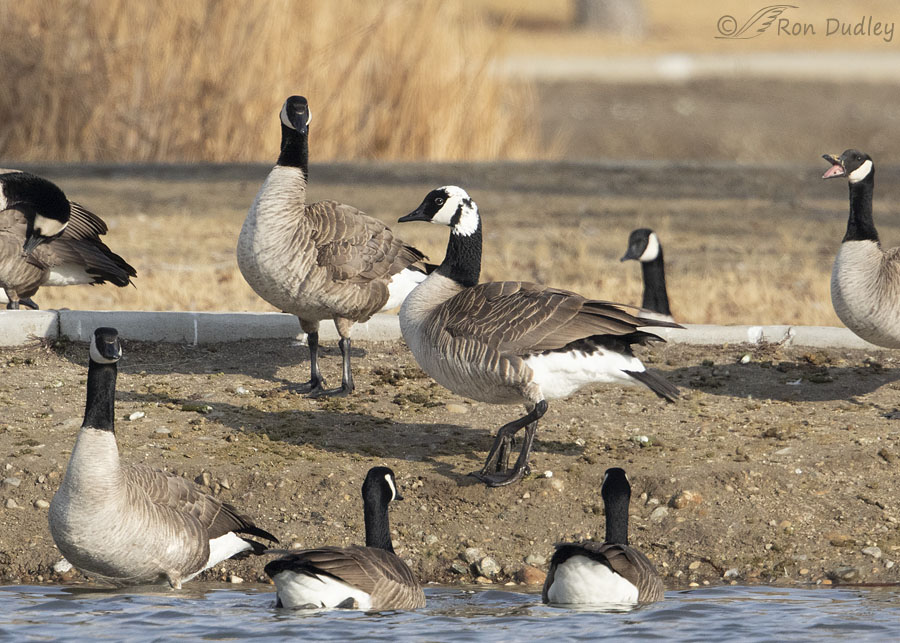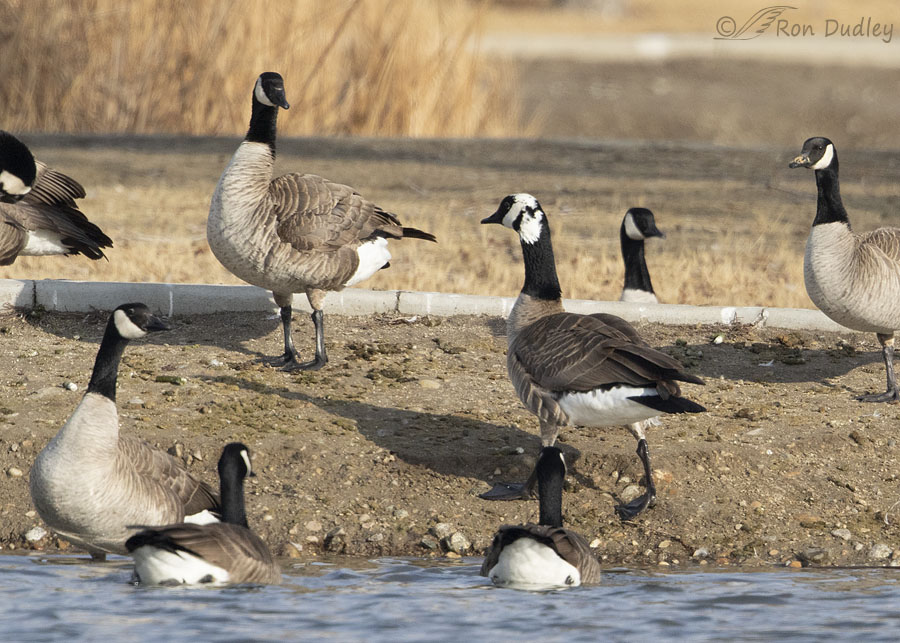It pays to keep your eyes open, even amongst ‘common’ birds.

Three days ago while attempting to photograph waterfowl on one of several local ponds I frequent I used my lens to scan a group of Canada Geese on the far away opposite shore and spotted a goose with unusual coloration on ‘her’ head and upper neck. She appears to be partially leucistic. Her white cheek patch extends over the top of her head in an unusual manner and there’s an additional atypical patch of white on the upper left side of her neck.The rest of her coloration appears to be normal for the species.
This photo amuses me because our special goose seems to be the center of attention of nearly all of her companions and given her flamboyant foot and leg pose she seems to know it as she poses for her admiring audience. The goose I cut off on the right frame edge appears to be announcing the entrance of her royal highness.

In a photo taken a few seconds earlier we can see a little more of her unusual coloration on the back of her head and neck. I never did get any photos of the right side of her head.
I’m always on the lookout for the unusual in the birds I photograph and when I find one that stands out I like to document it. They probably interest me more than they do many of my viewers but hey, it’s my blog…
Ron
Note: I’ve covered this before but I think it’s time to do it again.
I’m sure it makes some of my readers wince uncomfortably when I don’t know the sex of a bird but assign it a sex anyway, as I did today. When I do so it’s my custom to enclose the chosen pronoun in single quotes the first time I use it in the post to signal to my viewers that I don’t really know the bird’s sex.
It isn’t a perfect solution but I prefer doing that to repeatedly referring to the bird as “it” which I find too impersonal and even demeaning. And yes, I’m aware of several gender-neutral pronouns that have been proposed but I’m even more uncomfortable with them because they’re not universally known. Many readers would wonder what the hell I’m talking about.
It’s an imperfect world and English is an imperfect language.



The first photo reminds me of the bonnets women used to wear. I think she’s quite attractive. Perhaps some offspring will inherit the marking.
Now I want to see this Rossy!
Shane, she was just down the hill from you at the fishing pond a few days ago. They come and go but she might still be there…
Glad your back is better today (I spoke to soon yesterday and jinxed mine
 ).
).
She is one lovely goose. I laughed out loud at your “announcement” comment. He does seem to be trumpeting her arrival. She’s definitely strutting her stuff!
BTW, I have absolutely no problems with your selecting pronouns when you’re not sure.
You definitely have my sympathy regarding your bad back, Marty. I hope it improves very soon.
I really appreciate your ability to point out subtle interesting features in your subjects as well as the composition and setting. I did not notice that pose but you were right on!
Kenneth, part of that ability is because I have to pay so much attention to details when I’m processing my photos for my blog. But I appreciate that you noticed.
I love your narrative, she’s modeling/posing, the other one is announcing her entrance..
Glad to read your back is better today, the pain relief is always such a … relief!
And now I need to look up Everett’s Ross’s Goose.
“I love your narrative, she’s modeling/posing, the other one is announcing her entrance”
Good! I suspect that when I write in that style about birds it probably drives some folks nuts but it seems appropriate enough to me and I enjoy doing it. Thanks, Chris.
Coloration variants and leucistic occurrences are fun to look for in animals.
Agreed, April.
In the first photo it looks to me like she’s got an ice pack for a tooth ache.
I kinda see what you mean, Nancy.
I wonder if that Goose wonders why it gets all that attention, never to know the reason. Kind of like walking around with toilet paper on your shoe, but in a good way.
Now that TP comment brought back memories of another photograph many of us have seen.
Love your photos! This one in particular was quite interesting. I’ll be more careful at taking a good look at the common guys out there. Ya never know what you may find!
Nope, ya never know Dolores. Oddities come along more often than one might think.
An interesting looking bird. Leucistic birds can have some odd patterns. Sometimes the patterns are very regular but they can also be more random looking as in this bird. Some people use the term partial albino for such birds but your use of leucisic is more accurate. Many things can cause a lack of pigment to be deposited in these feathers and most have nothing to do with albinism, which is much more specific My guess would be female but that could very easily be wrong. I’m making a guess of female because the neck looks relatively short. (Males have longer necks.) Be that’s unwise to say for certain based on only a photo. Neck length can change as the bird stretches or contracts its neck. This kind of judgement is best made when you can compare two birds of a pair and watch them for some time.
Dan, I believe females are also slightly smaller than males but as you say I’m certainly not going to call that based on one photo. I think that size difference is quite a small one.
The only times I’ve been certain of sex in this species has been based on behavior.
Love that pose. Cat walk modelling at its very best.
How is your back today?
So far it’s significantly better today, EC. Thanks for your concern.
She’s definitely posing. Love it. Quite pretty too.
Thanks, Arwen.
It is interesting coloring and that the other geese appear to “notice” tho doesn’t appear they are ready to run her out. Kind of reminds me of some of the domestic geese unintentional crosses that happen and result in some different patterns. Good capture!
Thanks, Judy. I don’t believe she’s a hybrid but I suppose it’s possible.
Good observation Ron and she does appear to be the center of attention. Always interesting when you discover something unusual about a very common species.
Just a week ago I discovered that one of our visiting Snow Geese was a Ross’s Goose. I would never have known that, but while I was taking some photos of them at one of our lakes I ran into one of our local bird experts who told me the one I was taking photos of was a Ross’s and explained the difference. A first for me.
Thanks, Everett. And congratulations on your Ross’s Goose.